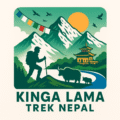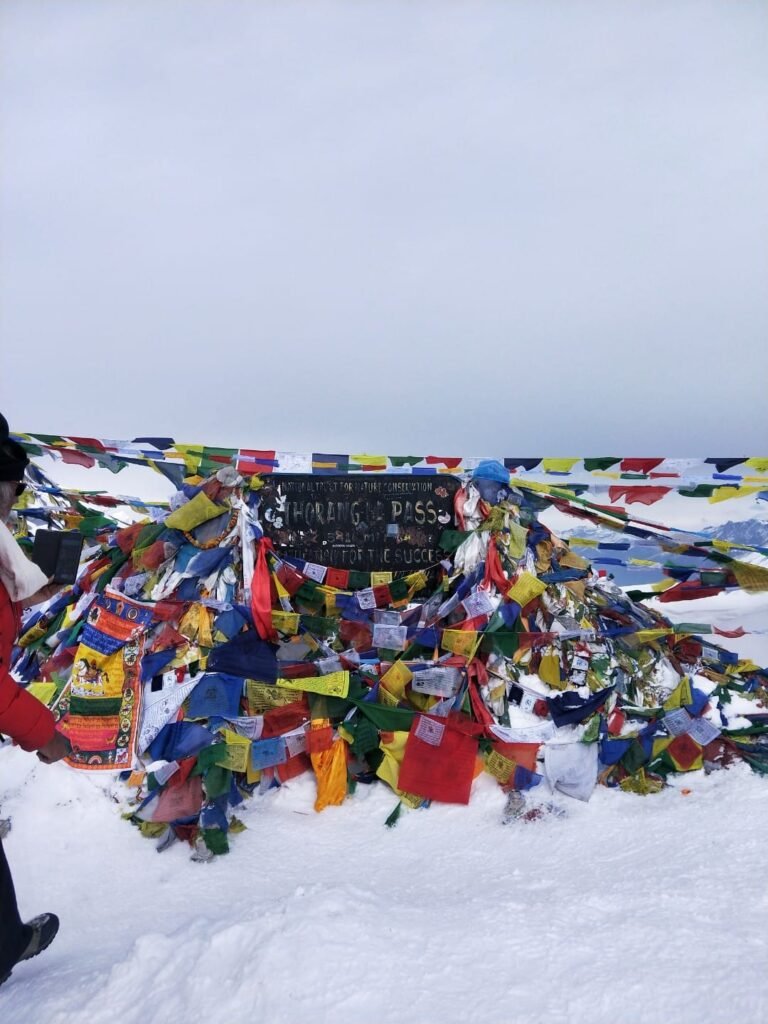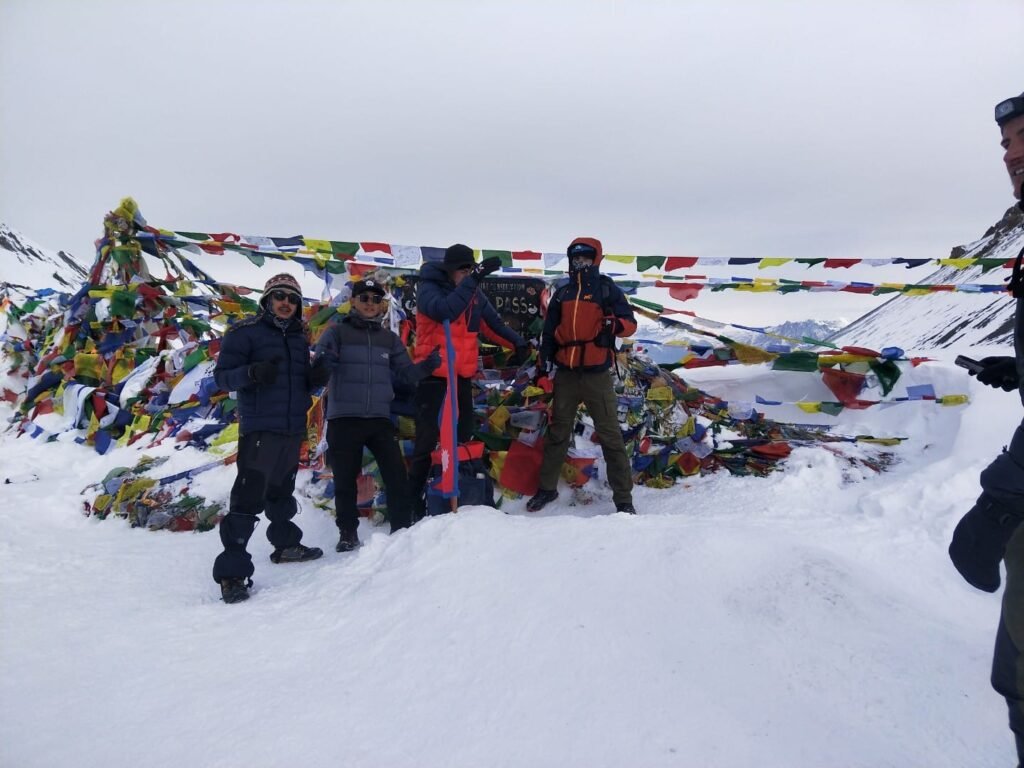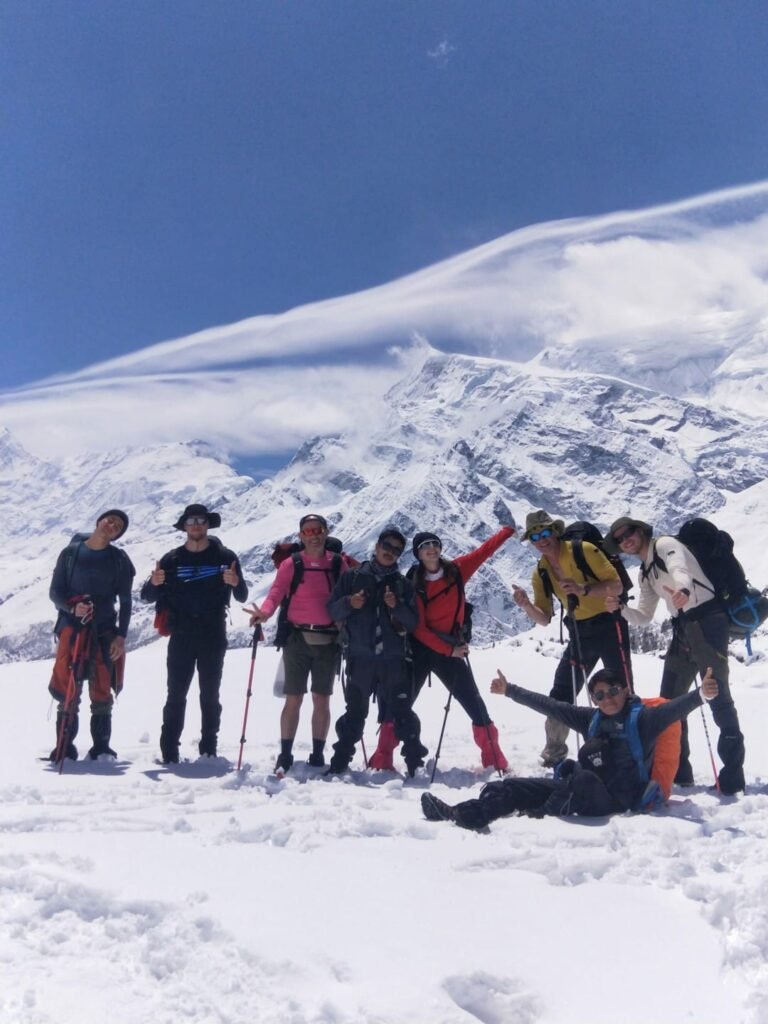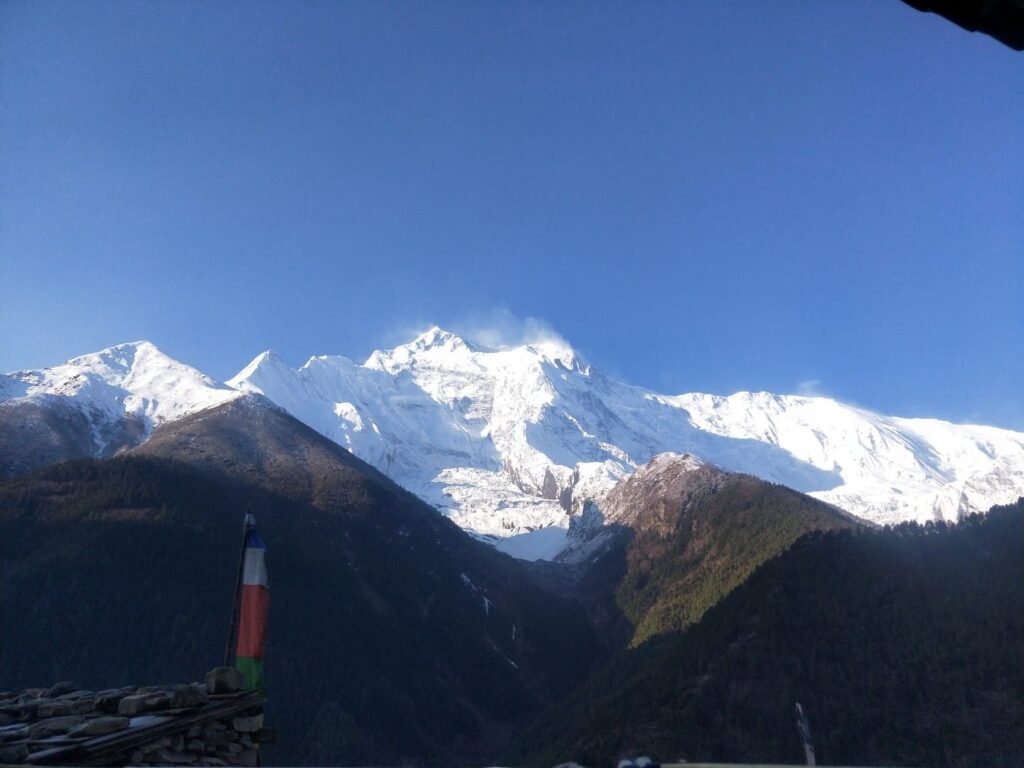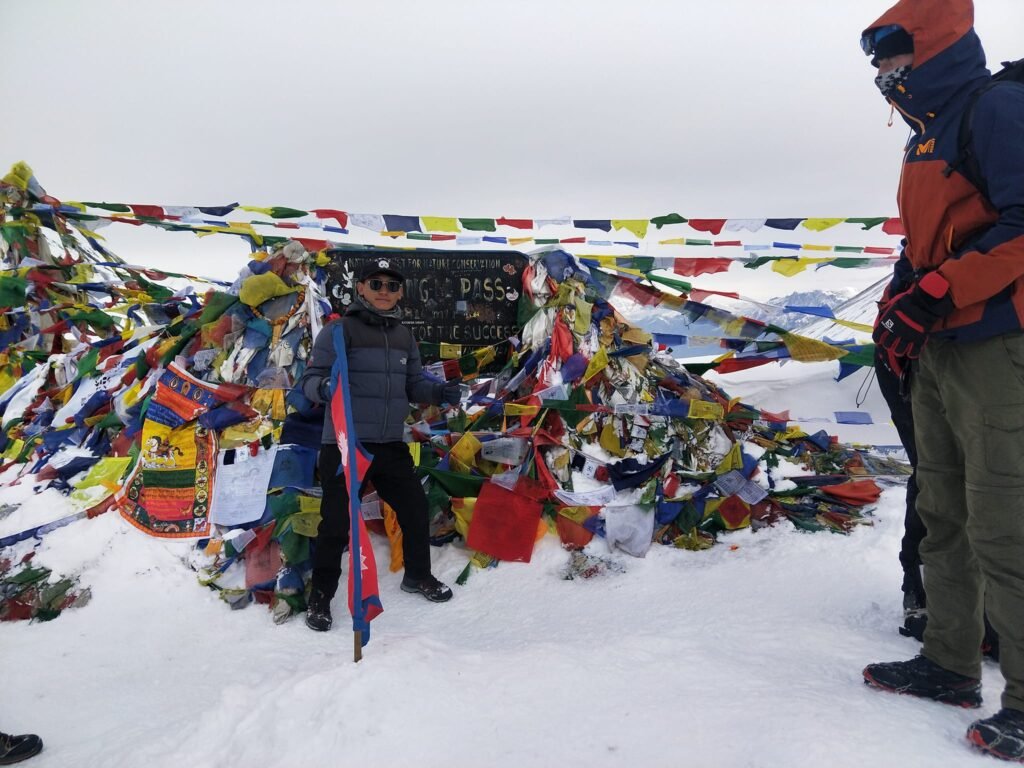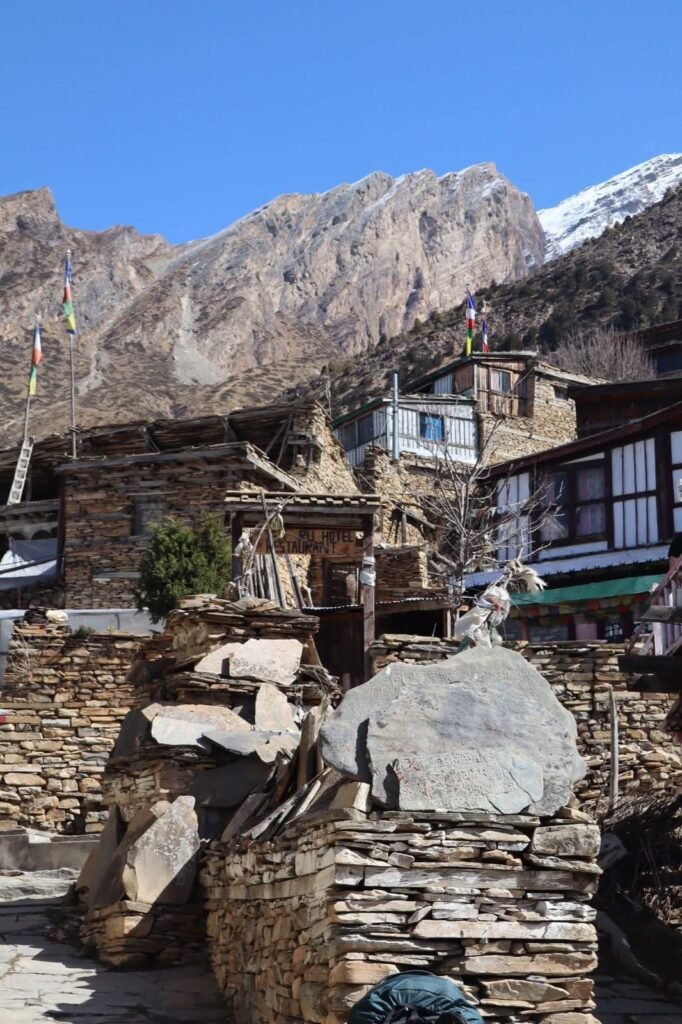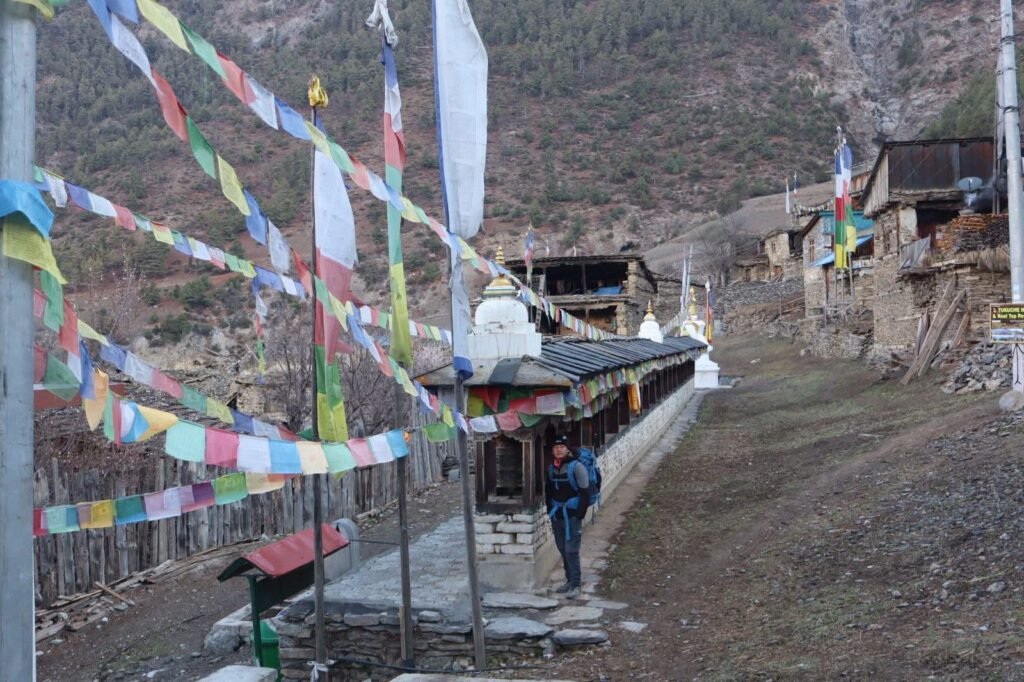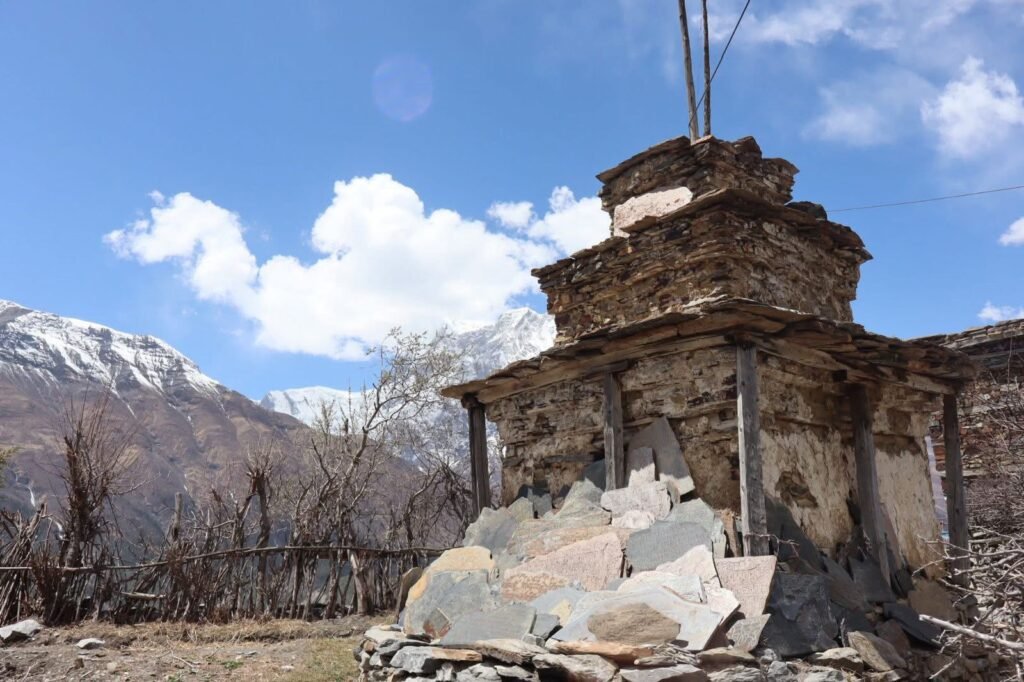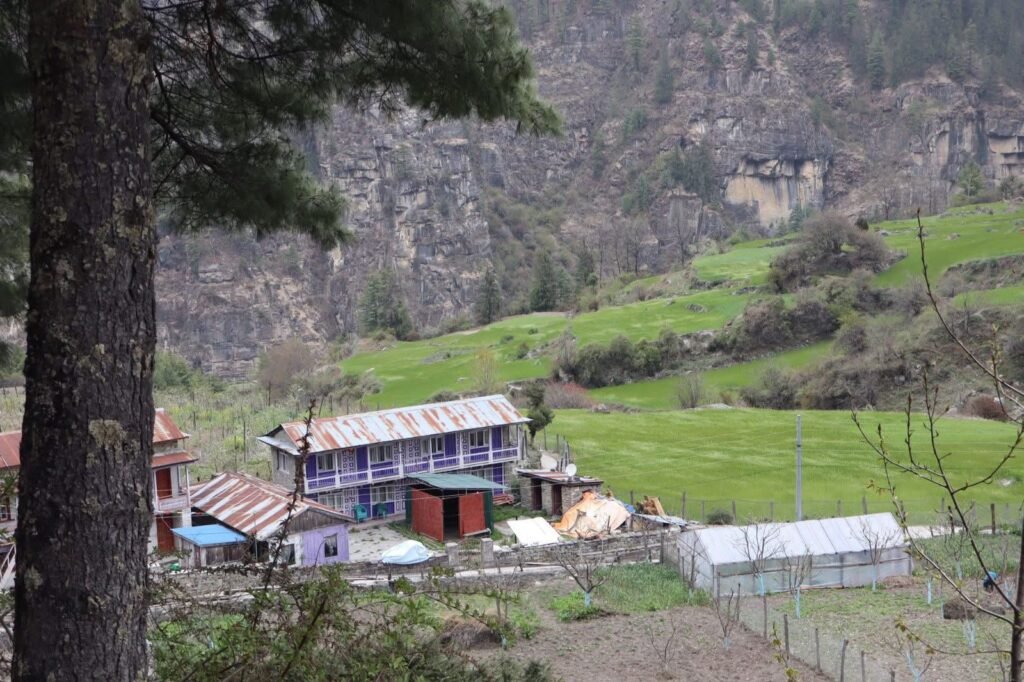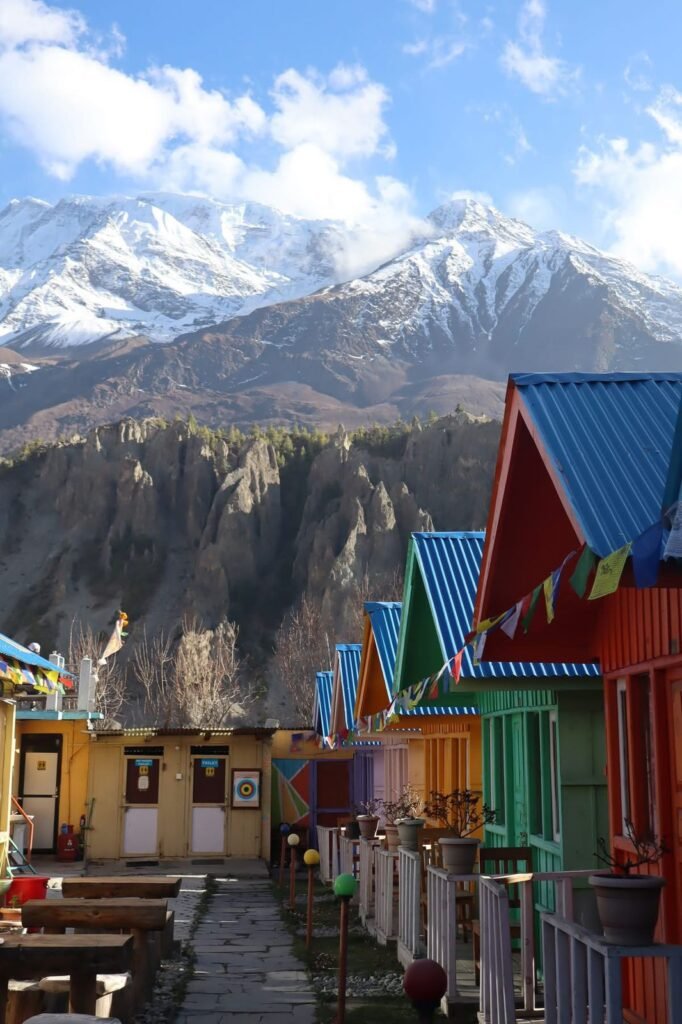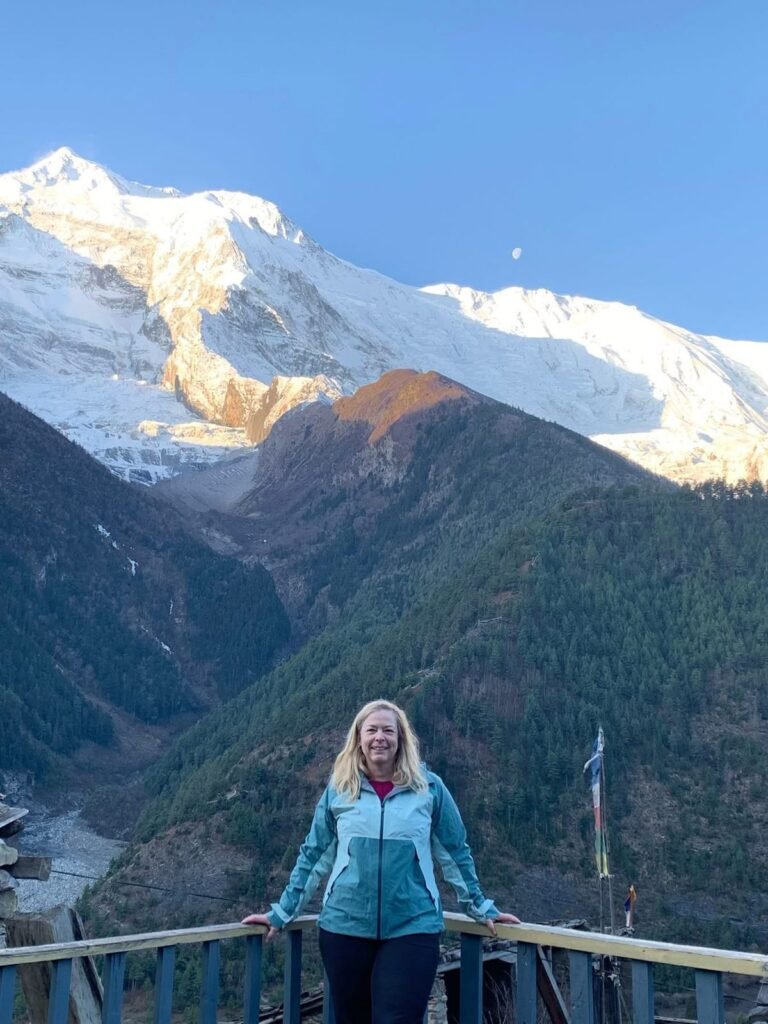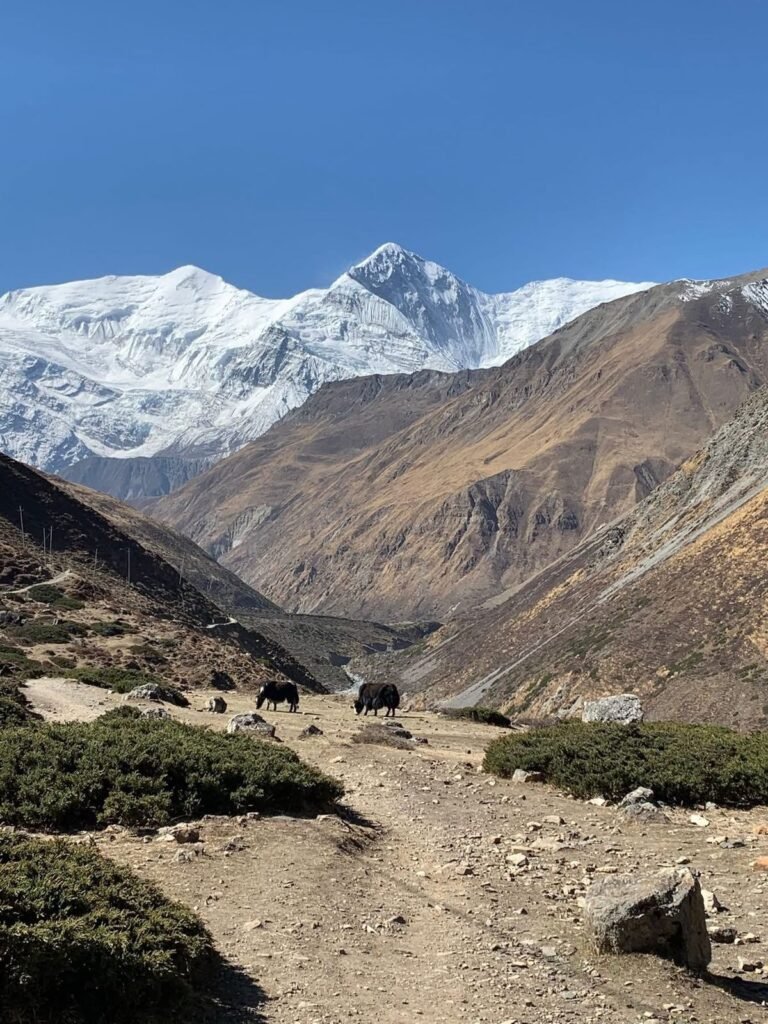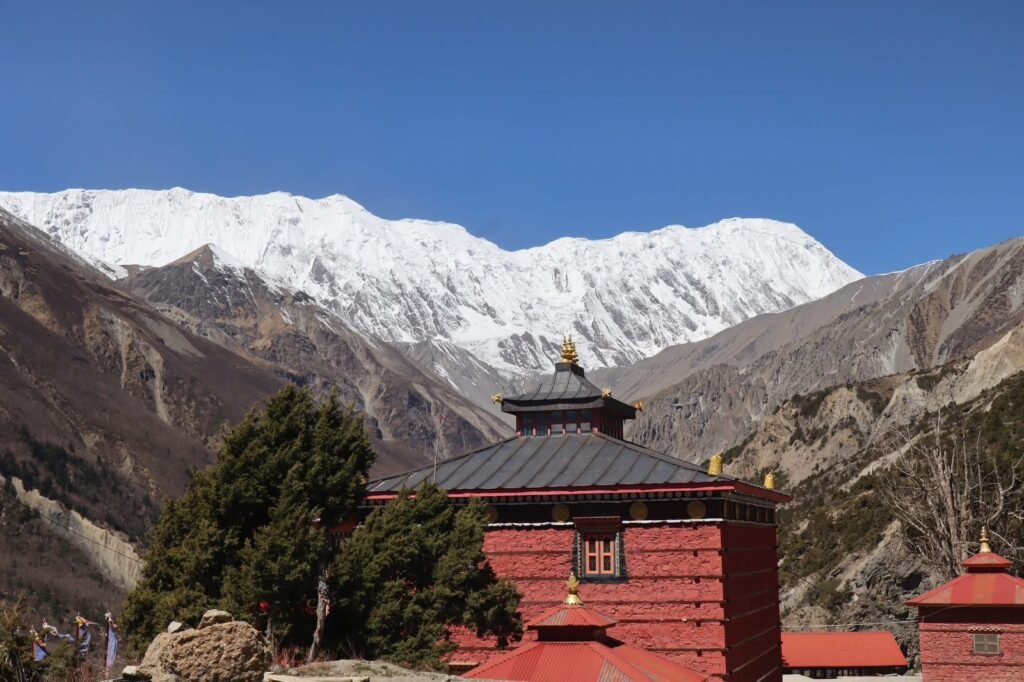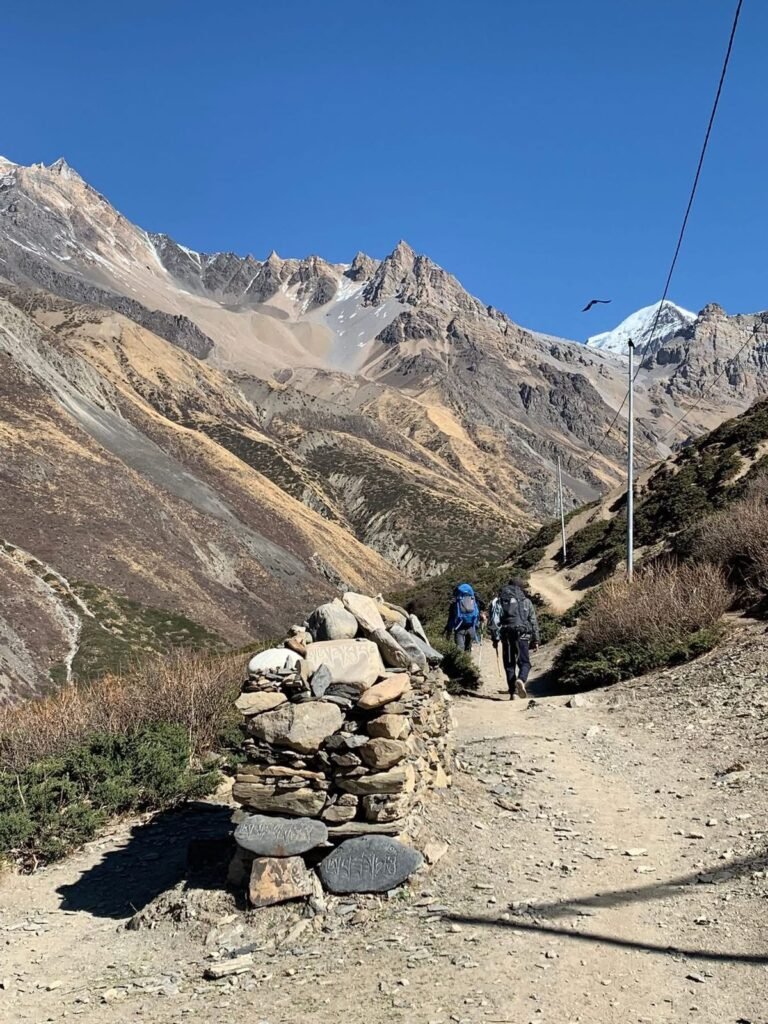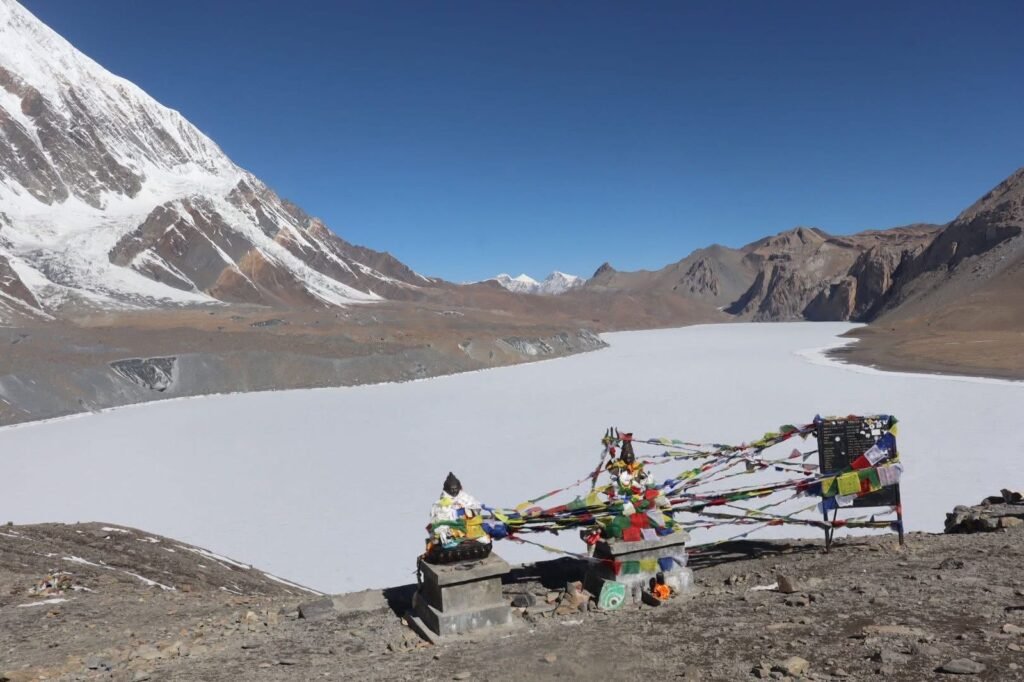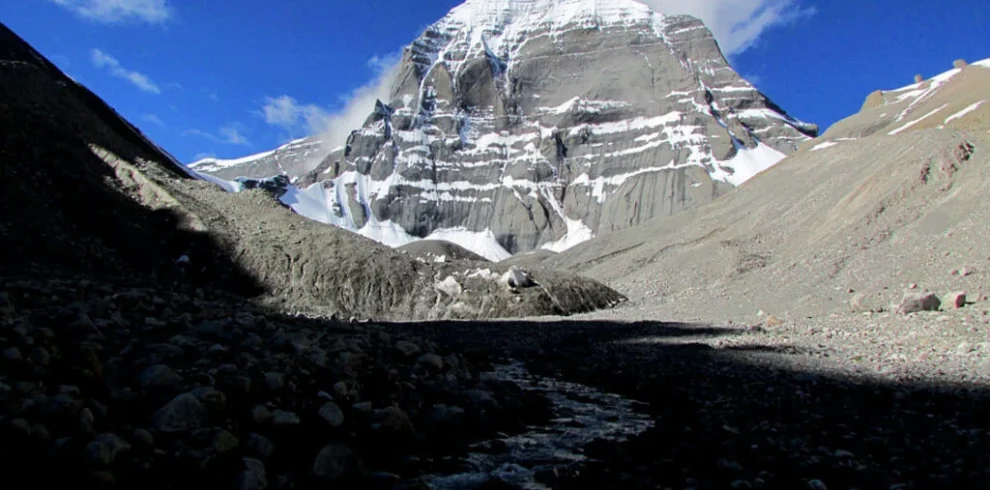Pricing is negotiable and can be discussed in USD or Euros.
The Annapurna Circuit trek is within the mountain ranges of central Nepal. The total length of the route varies between 160–230 km (100-145 mi), depending on where motor transportation is used and where the trek ends. This trek crosses two different river valleys and encircles the Annapurna Massif. The path reaches its highest point at Thorung La pass (5416m), reaching the edge of the Tibetan plateau. Most trekkers hike the route anticlockwise, as this way the daily altitude gain is slower, and crossing the high Thorong La pass is easier and safer.
Annapurna Circuit has been voted the best long-distance trek in the world, as it combined, in its old full form, a wide variety of climate zones from the tropics at 600 m asl to the Arctic at 5416 m asl at the Thorong La pass and cultural variety from Hindu villages at the low foothills to the Tibetan culture of Manang Valley and lower Mustang. Continuing construction of a road has shortened the trail and changed the villages. The Beisahar-Manag road has been built, which passes through the trekking trail much of the time. With the construction of roads, mountain biking is becoming popular, with Mustang, in particular.
Overview
The mountain scenery, seen at close quarters includes the Annapurna Massif (Annapurna I-IV), Dhaulagiri, Machhapuchhre, Manaslu, Gangapurna, Tilicho Peak, Pisang Peak, and Paungda Danda. Numerous other peaks of 6000-8000m in elevation rise from the Annapurna range.
Trip Highlights
- Pass by the yak pastures.
- Natural hot springs at Tatopani where you can choose to take a dip.
- Jomsom - the headquarter of Mustang.
- A day at tourist hub Pokhara.
- Spectacular views of Mt. Annapurna, Thorung Peak, Nilgiri, Chulu West, and Chulu East, Tukuche Peak, Dhaulagiri, Lamjung Himal, Annapurna II, and Annapurna IV.
- Visit the beautiful Manang district.
- Magnificent lakes, glaciers, deep gorges, and stunning waterfalls.
- Visit Muktinath (a sacred place for both Hindus and Buddhists) known for 108 stone faucets, and eternal flame Cross Thorong La Pass at 5,416 meters.
- Visit Barge Monastery, the largest monastery in the Manang district.
- Poon Hill Viewpoint (3,210 m).
Itinerary
The drive from Kathmandu to Besisahar is about 175 km and takes 6 to 8 hours along the scenic but winding Prithvi Highway. From Besisahar, the journey continues to Dharapani (1,960m), which takes another 4 to 6 hours on rougher roads, often requiring a 4WD vehicle. Dharapani is a common starting point for treks into the Annapurna region.
The trek from Dharapani to Chame covers about 16 kilometers and typically takes around 7 hours. Starting at 1,960 meters, the trail gradually ascends through beautiful rhododendron forests, terraced fields, and traditional villages. Along the way, you'll cross rivers and enjoy views of the surrounding mountains. Chame, the district headquarters of Manang, sits at 2,670 meters and offers cozy teahouses, local shops, and stunning panoramic mountain views. This day involves steady uphill trekking but rewards you with a welcoming village atmosphere and an opportunity to rest before heading higher into the Annapurna region.
The trek from Chame to Upper Pisang is about 15 kilometers and takes roughly 5 hours. The trail ascends steadily through pine and rhododendron forests, offering breathtaking views of the Annapurna and Manaslu ranges. You’ll pass traditional villages and terraced fields along the way. Upper Pisang sits at 3,230 meters and is known for its stunning mountain panoramas, including close views of Annapurna II and Pisang Peak. The village has a peaceful atmosphere with charming teahouses, making it a perfect place to rest and acclimatize before continuing higher.
The trek from Upper Pisang to Manang is a challenging yet rewarding 21-kilometer journey that typically takes about 7 hours. The trail climbs steadily through rugged landscapes, passing through vast alpine meadows, rocky terrain, and scattered villages. As you approach Manang, the air becomes thinner, so it’s important to pace yourself and stay hydrated. Manang, located at 3,550 meters, is a popular acclimatization stop on the Annapurna Circuit. It offers well-established lodges, shops, and stunning views of surrounding peaks like Annapurna III and Gangapurna. The village’s peaceful atmosphere makes it an ideal place to rest and prepare for higher altitudes ahead.
Spending an acclimatization day in Manang is essential to help your body adjust to the high altitude of 3,550 meters. During this rest day, you can explore the village, visit the local monastery, or take short hikes to nearby viewpoints such as the Gangapurna Lake or the Himalayan Rescue Association clinic. These gentle walks help improve oxygen absorption and reduce the risk of altitude sickness. Manang offers comfortable teahouses, warm meals, and stunning mountain views, making it a perfect place to relax and recharge before continuing your trek higher into the Annapurna region.
The trek from Manang to Tilicho Base Camp is a challenging 11-kilometer journey that takes around 7 hours. The trail gradually ascends through rugged, high-altitude terrain, passing alpine meadows and rocky landscapes. Along the way, you'll enjoy spectacular views of the Annapurna and Tilicho ranges. As you climb above 4,000 meters, the air becomes thinner, so it’s important to pace yourself and stay well-hydrated. Tilicho Base Camp, at 4,150 meters, serves as the gateway for those wishing to visit Tilicho Lake, one of the highest lakes in the world. The base camp offers basic teahouses and stunning panoramic mountain vistas, making it a rewarding stop for trekkers seeking adventure and natural beauty.
This day involves a rewarding hike from Tilicho Base Camp to Tilicho Lake, one of the highest alpine lakes in the world, situated at 4,919 meters. The 6-kilometer round trip typically takes about 4 hours. The trail climbs steeply through rocky terrain and sparse vegetation, offering breathtaking views of towering peaks and the pristine turquoise lake. After reaching Tilicho Lake, you’ll spend some time taking in the serene beauty before descending back to Shree Kharka at 4,065 meters. This descent allows your body to recover while you enjoy spectacular mountain scenery and the peaceful atmosphere of this remote area.
The trek from Shree Kharka to Yak Kharka covers 11 kilometers and takes about 5 hours. The trail gently descends and then gradually ascends through open alpine landscapes dotted with yak grazing pastures. Along the way, you’ll enjoy sweeping views of snow-capped peaks and vast valleys. Yak Kharka, situated at around 4,000 meters, is a small yak herders’ settlement with basic teahouses, offering a quiet and authentic mountain experience. This stretch provides a peaceful environment to rest and prepare for the upcoming climb toward higher elevations on the Annapurna Circuit.
The trek from Yak Kharka to Thorong High Camp is an 8-kilometer ascent that takes about 5 hours. The trail steadily climbs through rocky, high-altitude terrain with sparse vegetation. As you gain elevation, the air becomes thinner, so pacing yourself and staying hydrated is essential. Thorong High Camp, located at 4,800 meters, is the final stop before the challenging Thorong La Pass crossing. The camp offers basic lodges and spectacular views of the surrounding Himalayan peaks, providing a crucial resting point to prepare for the early morning summit attempt.
Crossing Thorong La Pass at 5,416 meters is the highlight and most challenging part of the trek. The early morning ascent starts from Thorong High Camp, with steep switchbacks and thin air making the climb physically demanding. Reaching the pass rewards you with breathtaking panoramic views of the Himalayas. After crossing the pass, the trail descends sharply for about 17 kilometers over 8 hours to Muktinath, a sacred pilgrimage site at 3,750 meters. The descent offers stunning landscapes, waterfalls, and unique cultural experiences. Muktinath provides comfortable lodges and a chance to rest after the strenuous pass crossing.
The trek from Muktinath to Jomsom covers about 18 kilometers and usually takes around 6 hours. The trail gradually descends through dry, desert-like landscapes characteristic of the Mustang region, with stunning views of rugged cliffs and the Kali Gandaki River below. Along the way, you’ll pass small villages and traditional Tibetan-style settlements. Jomsom, at 2,700 meters, is a lively town with shops, cafes, and a small airport, making it a popular endpoint for trekkers. It’s an ideal place to rest and enjoy modern amenities after days in the mountains.
The trek from Jomsom to Kalopani is approximately 23 kilometers and takes around 6 hours. The trail follows the Kali Gandaki River valley, gradually descending through semi-arid landscapes dotted with small villages and terraced fields. Along the way, you’ll enjoy panoramic views of the Annapurna and Dhaulagiri mountain ranges. Kalopani, at 2,500 meters, is a peaceful village offering basic teahouses and a quiet atmosphere, making it a good place to rest and experience local culture before continuing your journey.
The trek from Kalopani to Tatopani covers about 22 kilometers and takes roughly 6 hours. The trail descends steadily through lush forests, terraced fields, and traditional villages, offering beautiful views of the surrounding hills and mountains. Tatopani, meaning “hot water,” is famous for its natural hot springs—perfect for relaxing tired muscles after a long day of trekking. The village has comfortable lodges and a welcoming atmosphere, making it an ideal spot to rest and rejuvenate before continuing your journey.
The trek from Tatopani to Ghorepani is a challenging 16-kilometer hike that takes about 7 hours. The trail ascends steadily through dense forests of rhododendron, oak, and pine, passing charming villages and terraced fields. Along the way, you’ll climb numerous stone steps, making this section physically demanding but rewarding. Ghorepani, situated at 2,870 meters, is famous for its stunning panoramic views of the Annapurna and Dhaulagiri ranges, especially from nearby Poon Hill. The village offers cozy teahouses, making it a popular overnight stop for trekkers seeking rest and spectacular mountain vistas.
Start your day with an early morning hike to Poon Hill, about 3,210 meters high, to witness a breathtaking sunrise over the Annapurna and Dhaulagiri mountain ranges. The short but steep climb offers stunning panoramic views that make the effort worthwhile. After soaking in the scenery, you’ll descend towards Ulleri, trekking about 7 kilometers in total over 4 hours. The trail winds through forests and traditional villages, gradually descending to Ulleri at 2,100 meters. Ulleri is known for its long stone stairway and serves as a restful stop with basic teahouses and warm hospitality.
On this final trekking day, you descend from Ulleri to Birethanti, covering around 10 kilometers through lush forests and peaceful villages. The trail is mostly downhill and offers a relaxing end to your trek, passing through rhododendron and oak trees along with scenic views. Upon reaching Birethanti, the gateway to the Annapurna region, you’ll board a vehicle for a drive back to Pokhara. The drive takes about 1 to 1.5 hours, offering beautiful views of rivers, hills, and the surrounding countryside. Once in Pokhara, you can enjoy the comforts of this vibrant lakeside city and celebrate completing your trek.
After days of trekking, a rest day in Pokhara offers the perfect opportunity to relax and recharge. Known for its stunning natural beauty, Pokhara sits beside the serene Phewa Lake, surrounded by snow-capped Himalayan peaks. You can enjoy a leisurely boat ride on the lake, explore the lively lakeside markets, or visit popular spots like Davis Falls and the World Peace Pagoda. Pokhara also has cozy cafes, restaurants, and spas where you can unwind. This restful day lets you soak in the peaceful atmosphere, recover your energy, and prepare for your onward journey.
After completing your trek, you'll drive back to Kathmandu through scenic countryside roads. When you're ready for your international flight, a representative from Kinga Lama Trek Nepal will transfer you to Tribhuvan International Airport (TIA) for your final departure.
Cost
Cost Includes
- Airport pick up and drop off service.
- 3 night boutique Hotel in Kathmandu with breakfast.
- One night hotel in Pokhara with breakfast.
- Full board meals throughout the trip (Breakfast, Lunch, and Dinner).
- Government license holder mountain guide as included his salary, food, accommodation, and insurance.
- One Porter for each two clients (Porter service not available for Solo travel).
- Annapurna Conservation Area Project Permits.
- Trekking permit: ‘Trekkers’ Information Management System (TIMS).
- Kathmandu to Besi Sahar by local bus and Pokhara to Kathmandu Sofa tourist bus.
- Besisahar to Chame by local sharing jeep.
- Nayapul to Pokhara by private vehicle.
- Private local tea house accommodations during the trek.
- Three times tea or coffee during the trek.
- Fresh fruit during the trek.
- Medical first aid kit box.
Cost Excludes
- Your Travel and rescue insurance.
- All the Food in Kathmandu. Also in the case of early return from the mountain (due to any reason).
- All the expenses in the mountain over than scheduled itinerary (due to strike, delay or canceled flight)
- Extra night Hotel in Kathmandu if arrive early or late departure than scheduled Itinerary.
- All the Bar bills and personal expenses (phone call, laundry service, battery recharge, a bottle of water, hot water, shower.
- Tips for the guide and porter.
FAQs
Yes, the Annapurna Circuit Trek is also known as the Annapurna Round Trek. The journey encircles the Annapurna Massif. It is one of the most intriguing detours to walk in the Annapurna region of Nepal. You can find different names for the Annapurna Circuit Trek. These different names are Thorong La Pass Trek, Annapurna Round Trek, Annapurna Circuit Trek, Tilicho Lake Trek, with Annapurna Circuit Trek etc. Even if the trekking route has different names, the essence is the same. You can book the trekking trip around the Annapurna Massif by booking under any name that you deem okay. In fact, whichever name you prefer to call the trip is the Annapurna Circuit Trek in Nepal.
Valid travel insurance is needed for travelers to trek in Nepal. You must buy a travel insurance package in your home country. Make sure to provide a copy of your travel insurance to your trekking agency based in Kathmandu. If you do this, then in case of an emergency, they can activate the clause of your insurance and carry out the rescue activities. Even if you don’t have insurance, the agency will activate your rescue procedures, but it may result in your personal expenses. Therefore, getting travel insurance assures your own safety.
Yes, the Annapurna Circuit Trek with the alternative name as either the Annapurna Round Trek or as the Ghost Trail run by Arya Stark in the famous Game of the Thrones episode presenting similar traits. Trekkers shouldn’t miss out the fact that the trekking route was opened in 1977 A. D. Today’s date is 2015then you can easily figure out that how experienced the team of Kinga Lama Trek Nepal is? We offer you the best amenities and information while doing this classical trekking trip in Nepal.
The journey to the base camp of the world’s 10th-tallest mountain is a journey of a lifetime. You can easily knit the momentous travel tales that you can share with generations to come. However, the journey may inspire you to visit other destinations in Nepal. The trip to Annapurna Base Camp takes trekkers to the foothill of the world’s 10th-tallest mountain, Mt. Annapurna. However, the trip of the Annapurna Circuit Trek encompasses almost every village in the multi-ethnic villages of the Annapurna region. Moreover, the journey is full of mountain wilderness as well as cultural diversity. In this journey, trekkers can immerse themselves in the Gurung, Magar, Tibetan, and Thakali people’s culture in Nepal. Yes, the mountain and hilly scenery is there, but at the same time, they will be able to experience at least the culture and traditions of more than three ethnic groups of Nepal.
